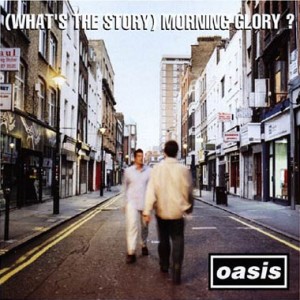
"(What's The Story) Morning Glory?"(Oasis' Second Album) Included Their Defining Hits "Don't Look Back In Anger" & "Wonderwall".
To review this (the very first CD I ever bought) fills me with a strange mixture of emotions. Most of all, I feel as if washed over and stripped of all experience by a wave of nostalgia as I realize how innocent I was back then. How I absorbed every instrument, how I thought each lyric over and over and how certain songs like “Hey Now” and “Don’t Look Back In Anger” marked the end of my teenage days. “There’s no time for running away now”.
But leaving aside its retrospective value, it is impossible to refute the appeal of this CD. “Definitely Maybe” was certainly more “Definitely” than “Maybe” in terms of quality, but its sound scheme was too lineal. With this album, Oasis discovered that their sound could be occasionally vulnerable without them being portrayed as weak because of that.
The first single was “Some Might Say”, a song Noel wrote while the rest of the band was being ejected from R & R misbehavior from a hotel the previous year. It was their first number one, after having chased the top of the charts like crazy. The song reprised T-Rex’s “Get It On” and had Liam singing “sunshine” in the vein of John Lennon, much as he had done on “Rock & Roll Star” from the previous disc.
Perversely enough, the second single to be culled from the disc was “Roll With It”. Fans and non-fans alike consider it one of the least-effective compositions of the period, even worse than most concurrent b-sides. The song is remembered as the one that constituted Oasis’ artillery in the “Battle Of The Bands” with Blur. It competed with “Country House” and while Blur won that battle Oasis is said to have won the war. But today most agree that Blur then won the whole campaign.
The song being released as a single probably had to do with the fact that Noel had written it for his girlfriend Meg when she had lost her job, and it stood to him as a show of support and affection. But it was just a loud number with a pedestrian melody and a lyric that repeated itself over and over nauseatingly. It had just a good snippet in the chorus: “D’you know I think I recognize your face/but I’ve never seen you before”. But that was the extent of quality in it.
The third single was a different story. A wonderwall one. The true inspiration behind the composition remains unclear, with their father (Thomas Gallagher) saying that the Wonderwall was a small wall in their backyard that the boys used to graffiti all over and slag each other off. The most likely theory is that Noel wrote it for Meg, and he took the expression from George Harrison’s first solo record. A composition that placed the lyrical weight on the word “maybe” in a similar way to “Live Forever”, “Wonderwall” turned the band into an indelible point of reference of the whole decade. You might not know it and you might not believe it, but “Wonderwall” failed to top the charts. Only one song in the whole decade could have kept it at number two. Elton John’s reworked “Candle In The Wind” (paying homage to Lady Di) held the top spot for the best part of two months, and when it was over the next single by Oasis saw release. It was the first to feature Noel on lead vocals, and it was their second number one single.
Continue to Part 2: “Don’t Look Back In Anger” and the rest of the album discussed and analyzed.

Pingback: (What’s The Story) Morning Glory? (Oasis) – Album Review (Part 2) | MusicKO
Pingback: Oasis: Revealed (Lee Henshaw) – Book Review | MusicKO
Pingback: Be Here Now (Oasis) – Album Review | MusicKO
Pingback: Create Music… By Drawing! | MusicKO
Pingback: Oasis – General Introduction | MusicKO